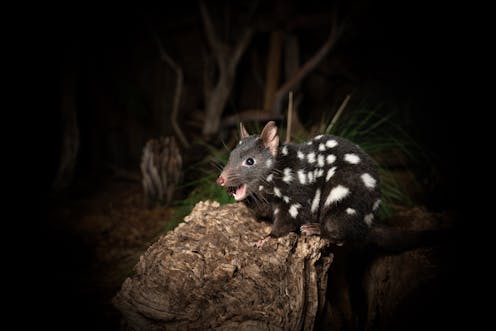Research reveals 111 times Australian quolls reportedly chewed on human corpses
- Written by David Eric Peacock, Adjunct Fellow, University of Adelaide

Warning: this article contains graphic descriptions of human disfigurement.
In 1878, the body of Sergeant Michael Kennedy lay in the bush in Victoria’s Wombat Ranges. He’d been shot by the notorious Ned Kelly gang – but the bush would add its own gruesome ending.
According to the man who later stumbled across his body, “one ear was gone. I imagined it had been gnawed away by native cats (quolls). The body was very much decomposed”.
This report is not isolated. My recent research has found 111 accounts between 1831 and 1916 where the scavenging of a corpse was attributed partly or entirely to quolls.
These grisly reports reveal a fascinating picture – not just of quolls, but of life in Australia in the 1800s.
A captivating carnivore
Quolls, historically known as native cats, are carnivorous marsupials. Four species are native to Australia: the spotted-tailed quoll, and the western, eastern and northern quoll.
Quoll populations in Australia have been declining for more than a century. Tasmania’s remaining eastern quoll population, for example, fell more than half in the decade to 2009 and numbers have not recovered since.
Quolls are known to scavenge. But I wanted to know more about their scavenging of human corpses. I hoped this would yield further insights into the animal’s diet and feeding behaviour.
Read more: Quolls are in danger of going the way of Tasmanian tigers
Delving into a gruesome history
Of the 111 historical accounts I found of quolls scavenging on a human corpse, six involved definitive evidence – either eyewitness accounts of the behaviour, or tracks and scats at the scene.
In 1862, a police officer saw seven quolls scavenging a corpse near Sale in Victoria. Upon being disturbed they ran into a dead tree. The policeman “burnt them and the tree to the ground” – revealing the widespread antipathy towards quolls at the time.
Tragically, in two cases quolls were seen feeding on infant corpses: at Araluen in New South Wales in 1895, and Sydney’s Middle Harbour in 1897.
And a sorry account tells of a man lost in the forest at Winchelsea in Victoria. Found near death, he said quolls and other animals “had eaten his fingers and his toes. They had bitten his face and torn his nose away”. He died soon after.
In 105 accounts I identified, quolls were not caught in the act of disfigurement, but were assumed to be the culprits.
In 1831, for example, Captain Bartholomew Thomas died in the Tasmanian bush after an Aboriginal spear attack during the Black War. When his body was found it was missing half the throat. A member of the search party speculated it had been eaten by crows or “native cats”.
In a modern context, it may seem a huge leap to attribute so many corpse disfigurements to quolls. And of course, correlation does not equal causation.
But during the period, quolls were a major problem. They were recorded invading homes and other buildings, and in one account from South Australia, someone’s bed.
In 1856 at Glencoe in South Australia, 550 quolls were killed in one day after the animals reportedly gnawed on boots and stock whips.
And quolls were, and remain, abundant in a few parts of Tasmania, threatening rabbits, chickens, poultry and captive birds.
So in this context, assuming a quoll was responsible for scavenging a human corpse was only natural.
What we can learn
In the 1800s and early 1900s, quolls were found across Australia. But the accounts I uncovered were limited to Tasmania, and a wide coastal-inland band from the Queensland/NSW border to just east of the South Australia/Victoria border.
Those areas had significant human populations – and newspapers to report their observations – which may explain the pattern. But at the time, the eastern quoll reportedly reached plague proportions in some places, and may have been desperate for food.
Quolls are beautiful and special animals. I want to spread their story far and wide in the hope efforts to protect them will be expanded.
In some cases, fox and cat control has allowed quolls to return to places they’ve been absent from for many years. But more conservation measures are needed.
Let’s hope quolls never again chew on a human corpse. But, restored to healthy numbers, perhaps they can resume their role in the bush as tough and wily predators.
Read more: Pet quolls are practically useless for real-world conservation
Authors: David Eric Peacock, Adjunct Fellow, University of Adelaide



















